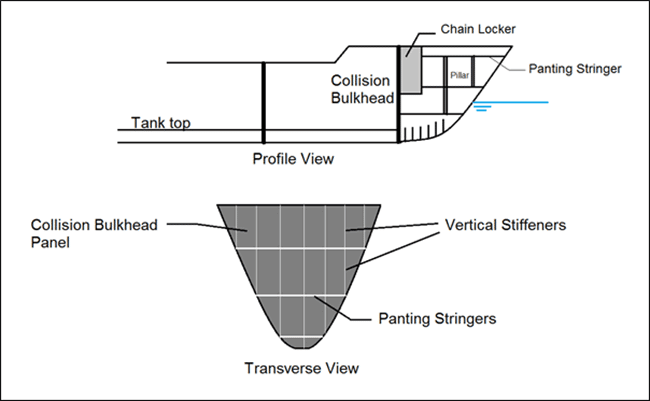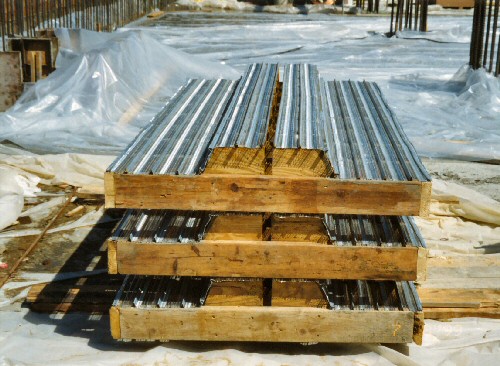Discovering the Various Uses Bulkhead Structures in Modern Architecture
Bulkhead structures play a significant role in modern style, serving both useful and visual functions. They can specify areas, improve storage space solutions, and improve illumination. In industrial settings, they act as focal factors that reflect brand identity - Bulkhead on Lake Livingston. Furthermore, their assimilation frequently sustains audio management and lasting practices. Understanding the full scope of their applications reveals much about contemporary style trends and individual experience. What cutting-edge uses bulkheads might emerge in the future?
Specifying Bulkhead Structures
Bulkhead structures play an important duty in modern style, functioning as crucial parts in numerous structure styles. These frameworks are typically specified as raised platforms or ceilings, usually used to conceal mechanical systems, electrical wiring, or pipes. Bulkheads can be located in both business and domestic settings, where they provide a seamless blend of capability and looks. Their layout can integrate illumination fixtures and other attractive components, boosting the overall aesthetic appeal of a space.
Commonly created from products such as timber, steel, or drywall, bulkheads can be personalized to fit the building style and needs of the structure (Bulkhead on Lake Livingston). They serve not only to hide unattractive framework but also to produce defined zones within open areas. By handling the circulation of a room, bulkheads add to the spatial organization, making them a substantial element of modern building technique. As a result, their interpretation envelops both useful and visual dimensions
Practical Applications in Residential Design
Bulkhead frameworks play a vital function in residential design by assisting in area optimization methods that optimize useful areas. They contribute aesthetic style elements that boost the visual charm of living areas. In enhancement, these frameworks offer vital structural support services, guaranteeing the integrity and security of the home.
Area Optimization Strategies
As modern-day property designs significantly prioritize effective use room, innovative strategies emerge to make best use of capability without sacrificing looks. One famous method entails the assimilation of bulkhead frameworks, which can delineate areas while giving important storage services. These structures can be utilized to produce upright storage units that enhance both organization and ease of access. Furthermore, multi-functional furniture, such as foldable tables and exchangeable couches, matches bulkhead layouts, enabling rooms to adapt to differing demands. Open up layout additionally maximize spatial flow, encouraging adaptability in usage. Including built-in shelving and recessed lights within bulkheads also adds to a streamlined setting, ensuring that fully of area is made use of efficiently and harmoniously within the general design.
Aesthetic Design Components

Structural Support Solutions
In contemporary household layout, an effective structural assistance solution is essential for preserving the honesty of spaces while maximizing design and functionality. Bulkhead structures play a significant role in this scenario, acting as both assistance and dividing components. They can hide mechanical systems, such as pipes and electrical wiring, while providing reinforcement to the ceiling and floor systems. By strategically putting bulkheads, engineers can create specified areas within open floor plans, boosting functionality without compromising architectural stability. In addition, these frameworks can suit lights fixtures, adding to both aesthetics and practicality. To sum up, bulkhead frameworks are crucial in domestic layout, supplying functional support options that boost both the performance and visual allure of living spaces.
Enhancing Looks in Business Areas
When industrial spaces accept ingenious bulkhead structures, they not only define physical limits however likewise considerably improve the general aesthetics of the setting. These building elements serve as visual prime focus, attracting attention and developing a feeling of intrigue. By including varied materials such as glass, steel, or wood, bulkheads can show a brand name's identity and mission, adding to a cohesive layout.
The critical placement of bulkheads can control light and darkness, including depth and measurement to or else level spaces. This interaction can change a business area right into an inviting ambience, urging client engagement. Furthermore, making use of color and appearance in bulkhead design can stimulate specific feelings, improving the overall client experience. Ultimately, the thoughtful combination of bulkhead frameworks raises the aesthetic allure of industrial rooms, making them not only useful but additionally visually charming, therefore fostering a long lasting impact on visitors.
Acoustic Performance and Audio Monitoring
Effective acoustic efficiency plays a vital function in modern design, specifically within commercial spaces where audio monitoring is vital. Bulkhead frameworks can significantly improve acoustic top qualities by taking in audio, reducing reverberation, and mitigating sound transfer in between locations. These functions are particularly advantageous in atmospheres such as movie theaters, dining establishments, and workplaces, where clear interaction and a pleasant acoustic experience are paramount.
The tactical placement and layout of bulkheads can help produce sound-buffer areas, effectively separating noisy areas from quieter ones. Products go to this web-site used in bulkhead building and construction, such as acoustic panels and soft finishes, add to their sound-dampening abilities. Furthermore, the unification of bulkheads permits the assimilation of sound-absorbing aspects without compromising aesthetic appeal. By dealing with acoustic performance, engineers can produce unified atmospheres that enhance comfort, enhance individual experience, and advertise performance, making bulkheads an important part in the style of contemporary business rooms.
Integrating Bulkheads for Efficient Room Usage
Typically neglected, the integration of bulkheads in architectural style can greatly improve area usage in modern-day buildings. These architectural aspects offer multiple sensible purposes, offering a method to conceal mechanical systems, electrical circuitry, and plumbing without jeopardizing aesthetics. By strategically placing bulkheads, engineers can produce specified locations within open flooring strategies, consequently facilitating much better organization and circulation.
Additionally, bulkheads can include storage solutions and lights functions, optimizing the capability of otherwise wasted upright room. In domestic settings, they may define zones such as kitchens or living locations, while in commercial spaces, they can enhance the effectiveness of designs by plainly noting pathways and workspace.
Eventually, the thoughtful integration of bulkheads adds to an extra visually attractive and orderly environment, enabling adaptable areas that can progress with the requirements of their residents. This approach not just maximizes area however additionally fosters a more unified communication between kind and feature.
Bulkheads in Public Architecture

Architectural Aesthetic Enhancements
While lots of building elements aim for capability, bulkheads in public style serve a twin function by enhancing visual appeal. These frameworks usually produce visual rate of interest through their design, integrating seamlessly with surrounding components. By using various products, textures, and shades, bulkheads can add to an one-of-a-kind identity for public rooms, such as airport terminals, galleries, and libraries. Their calculated placement assists to define locations, guiding visitors while adding depth to the overall design. Additionally, bulkheads can accentuate lighting, producing vibrant ambiences that change throughout the day. This aesthetic improvement not only boosts the visitor experience yet also promotes a feeling of area, making bulkheads an essential factor to consider in modern-day public design. Generally, bulkheads symbolize the combination of kind and function.

Structural Support Solutions
As architects seek ingenious ways to improve the architectural honesty of public rooms, bulkheads become vital elements in the layout and construction process. These frameworks provide crucial assistance, especially in locations based on hefty foot web traffic or dynamic tons. By distributing weight uniformly, bulkheads assist stop structural failure while enabling versatile design options. In huge places, such as arenas and convention facilities, bulkheads are often incorporated right into the total building structure, ensuring security and security. In addition, they can facilitate the incorporation of utilities and mechanical systems, adding to the effectiveness of room usage. Inevitably, bulkheads stand for a crucial solution in contemporary public style, strengthening both capability and safety and security you could try here in community-focused settings.
Environmental Management Steps
Incorporating environmental management procedures into public style has come to be significantly crucial as metropolitan designers focus on sustainability together with structural support. Bulkhead frameworks offer a dual purpose in this respect, serving as obstacles versus disintegration and flooding while concurrently boosting the visual allure of urban landscapes. Their layout typically consists of natural environments such as greenery, which can boost air quality and provide habitats for wild animals. Additionally, bulkheads can be crafted with absorptive products that enable water absorption, lowering drainage and advertising groundwater recharge. This assimilation of ecological considerations not only protects the atmosphere but also cultivates community strength against environment modification. By using bulkheads efficiently, designers add to sustainable city growth that lines up with contemporary ecological goals.
Future Fads in Bulkhead Layout
Arising patterns in bulkhead layout reflect an expanding focus on sustainability, development, and functionality in modern design. Developers are progressively including eco-friendly materials, such as recycled compounds and bioplastics, to minimize environmental effect. Furthermore, the assimilation of smart modern technology is becoming prevalent, making it possible for bulkheads to serve multi-functional objectives, including energy storage and environment control.
In city settings, modular bulkhead systems are acquiring traction, offering flexibility in layout and convenience of installation. These systems can be adjusted to various landscapes, allowing for effective area application. Furthermore, aesthetic factors to consider are developing; bulkheads are currently being created to improve visual charm, frequently integrating creative components that resonate with local society.
As environment resilience becomes a concern, future bulkhead layouts will likely prioritize flood protection and stormwater monitoring, guaranteeing structural stability while attending to environmental difficulties. This change represents a holistic technique to architecture that fulfills both ecological responsibilities and human requirements.
Regularly Asked Inquiries
What Materials Are Typically Utilized for Bulkhead Building And Construction?
Usual materials for bulkhead building and construction include concrete, steel, timber, and composite materials. These options give sturdiness, structural integrity, and resistance to environmental elements, making them appropriate for various applications in construction and engineering projects.
Just How Do Bulkheads Impact Building Energy Effectiveness?
Bulkheads enhance developing energy performance by offering thermal insulation and decreasing air leak (Bulkhead on Lake Livingston). They help preserve interior temperatures, thus lowering heating and cooling needs, ultimately resulting in lower energy costs and improved environmental sustainability
Exist Any Kind Of Building Regulations Certain to Bulkhead Structures?
Yes, developing codes details to bulkhead frameworks exist, differing by area. These policies generally attend to security, structural stability, and ease of access, making sure that bulkheads meet needed standards for building and construction and design within a given territory.
Can Bulkheads Be Easily Modified or Removed Later?
Bulkheads can commonly be changed or gotten rid of, relying on their layout and building. Nevertheless, such alterations might call for mindful preparation and adherence to building regulations to guarantee structural stability and safety and security are maintained throughout the procedure.
What Are the Prices Connected With Installing Bulkhead Frameworks?
The prices related to mounting bulkhead structures can differ considerably, usually influenced by products, style complexity, and labor. Usually, costs vary from moderate to high, depending upon the project's specific needs and area.
Bulkhead frameworks play a crucial function in modern style, offering as essential parts in various building designs. Bulkhead structures play a vital function in domestic layout by assisting in room optimization strategies that take full advantage her latest blog of usable areas. Commonly ignored, the combination of bulkheads in architectural style can considerably enhance area utilization in contemporary buildings. As engineers look for innovative ways to improve the architectural stability of public areas, bulkheads emerge as important components in the style and construction procedure. The prices linked with mounting bulkhead structures can vary considerably, typically influenced by products, layout intricacy, and labor.